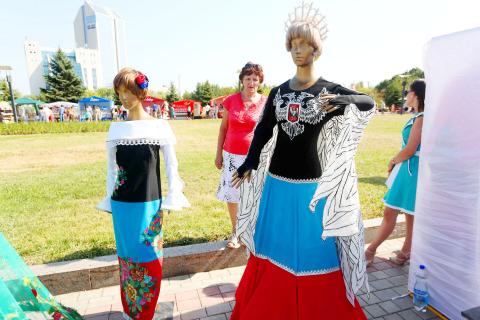In war-scarred eastern Ukraine, the military look is all the rage this season, with fatigues and Soviet regalia a must-have for those who dress to impress in the battered crucible of the Russian-backed insurgency.
With international brands such as Zara and Levi’s pulling out of the fighters’ de facto capital of Donetsk, it has created valuable space for local designers who fill boutiques with clothes that reflect the bleaker realities of everyday life.
Designer Yulia Morozova, 27, says her most popular outfit for women in this industrial city is a number called “the little lump of coal,” which she says symbolizes eastern Ukraine.

photo: AFP
The long black-and-grey gown is speckled with sparkles and topped off with a translucent scarf decorated in the blue-and-red motif of the flag of the self-proclaimed Donetsk People’s Republic.
The two-headed eagle — the emblem used by both the czars and Russian President Vladimir Putin — also features on a locally-designed evening gown.
WAR-TORN LOOK
The war in the EU’s backyard, which began in 2014, has claimed more than 10,000 lives — most lost to indiscriminate shelling or mines planted in exorbitant numbers by both sides.
These days, the conflict has calmed to low-intensity fighting in which periodic truces are sometimes broken but eventually peter out.
Some southeastern regions of the former Soviet republic remain firmly under separatist — and Kiev claims — Russian control.
Clothes have inevitably come to reflect this reality and the military look, along with old Russian standbys such as designs featuring nesting dolls, loom large in adverts on the high street.
One of Morozova’s more eye-catching dresses is called “The Young Republic,” which is overlaid in white embroidery and has full-length sleeves in the colors of the Donetsk flag.
“We all live in a young republic — it is only starting to grow,” Morozova tells onlookers at a special outdoor exhibition of creations by local designers.
Another dress features the hammer and sickle design on it “because we were all born in the Soviet Union,” she says.
‘A LA RUSSE’
Not everyone is so happy about the replacement of global brands by fashion “a la Russe.”
Former languages student Yelena — now unemployed and unwilling to give her last name for fear of retribution from pro-Russian rebels — walks out of a large Donetsk shopping mall without making a single purchase.
“These military, pseudo-patriotic motifs, these nesting doll designs, embroidery ‘a la Russe’ — none of it is quality material. I do not like any of it,” the 27-year-old says.
“A lack of demand and warfare have simply pushed good clothes out of Donetsk.”
The bustling city which was once home to nearly a million people has today been taken over by local businesses and a plethora of stores selling cheap knockoffs from Turkey and China.
Designer Tatyana Protchenko says her latest style inspiration came two years ago when the conflict was claiming lives almost every day. “It was spring, trees were blooming, it was warm and beautiful outdoors but the shells were exploding and people were dying,” Protchenko recalls.
“The war has made a profound impact on my collection.”
CLAD IN CAMO
But she insists her designs are not meant to promote warfare.
“The idea is that despite combat, the women of Donetsk remain delicate and feminine.”
But shopper Yelena questions why women would dress in military outfits or wear politically-charged flags of Russia and the two self-declared southeastern fiefdoms in times of war.
“You need this type of clothing for camouflage on the battlefield or to express your patriotism,” she says.
“But why would young women dress up in camouflage, and how can she help her country by pulling on a dress that looks like a flag?”
She shakes her head in disbelief.
“I think these things should be left for the politicians and the army men.”

As we live longer, our risk of cognitive impairment is increasing. How can we delay the onset of symptoms? Do we have to give up every indulgence or can small changes make a difference? We asked neurologists for tips on how to keep our brains healthy for life. TAKE CARE OF YOUR HEALTH “All of the sensible things that apply to bodily health apply to brain health,” says Suzanne O’Sullivan, a consultant in neurology at the National Hospital for Neurology and Neurosurgery in London, and the author of The Age of Diagnosis. “When you’re 20, you can get away with absolute

When the South Vietnamese capital of Saigon fell to the North Vietnamese forces 50 years ago this week, it prompted a mass exodus of some 2 million people — hundreds of thousands fleeing perilously on small boats across open water to escape the communist regime. Many ultimately settled in Southern California’s Orange County in an area now known as “Little Saigon,” not far from Marine Corps Base Camp Pendleton, where the first refugees were airlifted upon reaching the US. The diaspora now also has significant populations in Virginia, Texas and Washington state, as well as in countries including France and Australia.

On April 17, Chinese Nationalist Party (KMT) Chairman Eric Chu (朱立倫) launched a bold campaign to revive and revitalize the KMT base by calling for an impromptu rally at the Taipei prosecutor’s offices to protest recent arrests of KMT recall campaigners over allegations of forgery and fraud involving signatures of dead voters. The protest had no time to apply for permits and was illegal, but that played into the sense of opposition grievance at alleged weaponization of the judiciary by the Democratic Progressive Party (DPP) to “annihilate” the opposition parties. Blamed for faltering recall campaigns and faced with a KMT chair

A police station in the historic sailors’ quarter of the Belgian port of Antwerp is surrounded by sex workers’ neon-lit red-light windows. The station in the Villa Tinto complex is a symbol of the push to make sex work safer in Belgium, which boasts some of Europe’s most liberal laws — although there are still widespread abuses and exploitation. Since December, Belgium’s sex workers can access legal protections and labor rights, such as paid leave, like any other profession. They welcome the changes. “I’m not a victim, I chose to work here and I like what I’m doing,” said Kiana, 32, as she